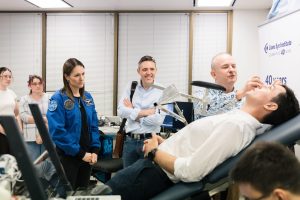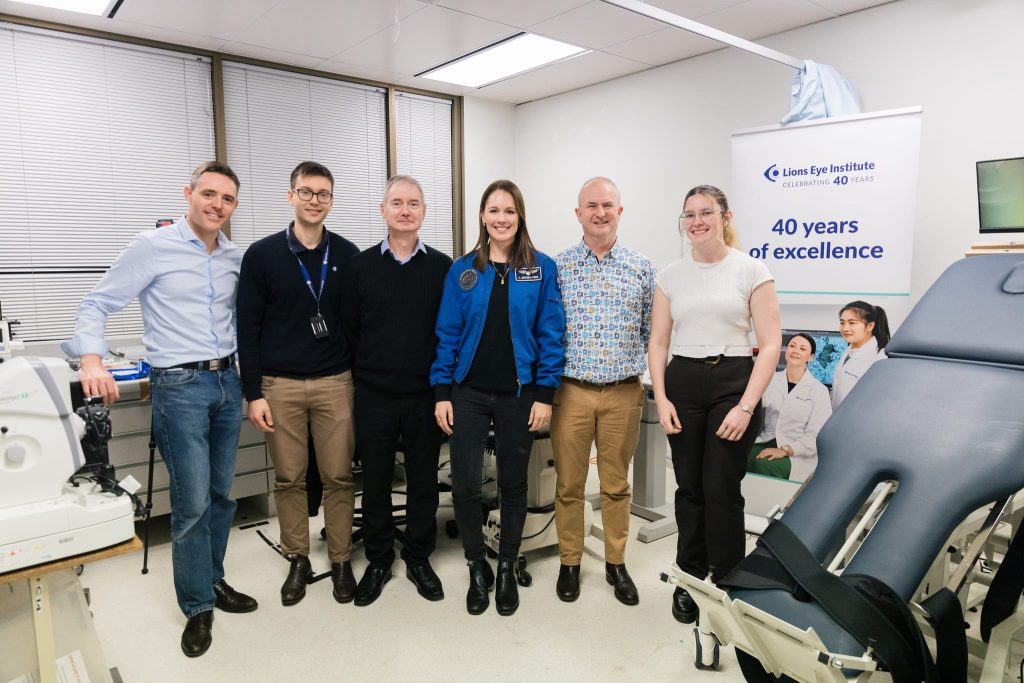Katherine Bennell-Pegg, the first astronaut to be qualified under the Australian flag, recently visited the Lions Eye Institute to witness pioneering research into a revolutionary non-invasive device designed to monitor intracranial pressure (ICP) – a crucial development with applications both in space and on earth.

Katherine Bennell-Pegg, Professor Danail Obreschkow and Lions Eye Institute researchers watch as Professor Bill Morgan prepares a test person to perform a non-invasive intra-cranial pressure measurement on the eye with OcuLinx.
The innovative device, known as OcuLinx, represents a significant leap forward in the field of medical technology. Developed by a team led by Professors Bill Morgan, Dao-Yi Yu AM, and Dr. Anmar Abdul-Rahman, OcuLinx is a portable, non-invasive tool that measures ICP by analysing large retinal vessel pulse amplitudes. This sophisticated technology utilises advanced image analysis, waveform analysis and artificial intelligence techniques to provide accurate readings of the pressure of cerebrospinal fluid surrounding the brain.
Elevated ICP can be indicative of various serious conditions, such as hydrocephalus, idiopathic intracranial hypertension (IIH) and acute neurological issues. Traditionally, measuring ICP has been invasive, involving lumbar punctures or internal sensors. These methods pose risks, are time-consuming and are not suitable for long-term monitoring. OcuLinx, however, offers a less invasive and potentially safer alternative, promising to transform how ICP is monitored and managed.
Key Applications:
- In space: Prolonged exposure to microgravity in space can lead to space-associated neuro-ocular syndrome (SANS), a condition that affects over 50 per cent of astronauts on missions longer than six months. Elevated ICP due to low gravity can result in severe outcomes, including vision loss. OcuLinx could become a vital tool in mitigating these risks by providing continuous, non-invasive ICP monitoring.
- On earth: OcuLinx has promising applications for patients with conditions like IIH, which predominantly affects young women and can lead to blindness. It also holds potential for improving outcomes in children with hydrocephalus and providing better differentiation in chronic headache cases. The device is designed to help identify treatment issues earlier and support timely interventions.
Currently, the OcuLinx portable prototype is nearing its first clinical trial in Perth. Support from the Western Australian Future Health and Research Innovation Fund has been instrumental in developing the prototype to clinical trial readiness.
Katherine Bennell-Pegg’s visit underscores the importance of integrating cutting-edge research with real-world applications. “The OcuLinx device represents a groundbreaking advancement in how we monitor intracranial pressure, both for astronauts in space and for patients on Earth. Its potential to improve outcomes in critical health conditions and space missions is truly exciting,” Professor Bill Morgan commented.
With commercialisation efforts targeting a global market entry by 2027-2028, OcuLinx aims to set a new standard in non-invasive ICP measurement. As development progresses, the team looks forward to further advancements and the positive impact this technology will have on both space exploration and medical practice.

Professor Danail Obreschkow from the University of Western Australia’s International Space Centre, Lions Eye Institute researchers Aleksandar Vukmirovic and Andrew Mehnert, Katherine Bennell-Pegg – the first astronaut qualified under the Australian flag, Professor Bill Morgan and UWA Honours student Jasmine Quin-Conroy (left to right).



